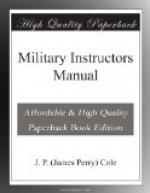WIG WAG.—Time spent: Same as semaphore course. The alphabet can be found in any standard signal book, or in the “Manual for Non-Commissioned Officers and Privates.” The dots are made to the right of the body, the dashes to the left; interval at the end of a word by dipping the flag once to the front, at the end of a sentence by dipping it twice, and at the end of a message by dipping it three times. The alphabet should be learned first according to the same general plan as in the semaphore; i.e., the key letters to certain combinations should first be learned. The following grouping of letters may be found helpful:
E I S H; T M O; A U V; N D B; R F L; K C Y; W P J; G Z Q.
The instructor can find many other groupings that will aid him. It should also be pointed out that each number from one to ten consists of five characters, and that each succeeding number follows the previous one according to a regular method.
After the men have studied the alphabet sufficiently, have them send to each other, limiting the work at first to letters only. Then gradually work up to the point where they may send simple messages. Make them rely upon the flags for communicating during the practice. Do not permit conversation—separate the men by a considerable distance. In both wig wag and semaphore instruction the same plan should be followed as in teaching a foreign language; i.e., confine all communication to the medium under study. Qualification tests are similar to those for the semaphore, except that less speed can be exacted; 15 characters per minute or 10 combinations of 5 letters each to be received and written down in 5 minutes.
In both the semaphore and the wig wag men should be taught the conventional signals used in field work. These can be found in any manual on the subject.
POINTS TO REMEMBER.
The semaphore is a quicker means of communication than the wig wag; but the wig wag can be used in a prone position under shelter.
Lanterns can be used at night for semaphoring.
Acetylene lamps can be used at night in place of the wig wag. In this case a short flash represents a dot, a long flash a dash.
A few men in each company should be developed into expert signalers; some men always show aptitude for this sort of thing.
Frequent use should be made of signaling in field work.
Letter Codes.
INFANTRY.
For use with General Service Code or semaphore hand flags.
--------------+---------------------------+------------




